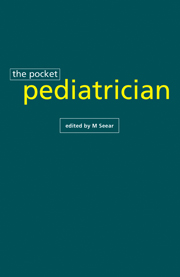Book contents
- Frontmatter
- Contents
- Analytical contents list
- Preface
- 1 Cardiology
- 2 Death and dying
- 3 Emergencies
- 4 Endocrinology
- 5 Fluids and electrolytes
- 6 Gastroenterology
- 7 General surgery
- 8 Health care ethics
- 9 Hematology
- 10 Infectious diseases
- 11 Intensive care and continuous infusion drugs
- 12 Medical genetics
- 13 Neonatology and neonatal drug dosage guidelines
- 14 Neurology
- 15 Nutrition
- 16 Oncology
- 17 Pediatric transport
- 18 Pharmacology and drug dosage guidelines
- 19 Renal
- 20 Resident fellow training
- 21 Respirology
- 22 Rheumatology
- 23 Transfusion medicine
- 24 Appendix
- Index
12 - Medical genetics
Published online by Cambridge University Press: 01 February 2010
- Frontmatter
- Contents
- Analytical contents list
- Preface
- 1 Cardiology
- 2 Death and dying
- 3 Emergencies
- 4 Endocrinology
- 5 Fluids and electrolytes
- 6 Gastroenterology
- 7 General surgery
- 8 Health care ethics
- 9 Hematology
- 10 Infectious diseases
- 11 Intensive care and continuous infusion drugs
- 12 Medical genetics
- 13 Neonatology and neonatal drug dosage guidelines
- 14 Neurology
- 15 Nutrition
- 16 Oncology
- 17 Pediatric transport
- 18 Pharmacology and drug dosage guidelines
- 19 Renal
- 20 Resident fellow training
- 21 Respirology
- 22 Rheumatology
- 23 Transfusion medicine
- 24 Appendix
- Index
Summary
INTRODUCTION
Definitions
Congenital anomalies are structural or anatomical defects of varying significance:
Major anomalies require medical or surgical attention or are of social concern.
Minor anomalies are those that are neither medically nor socially significant.
Syndromes are etiologically related congenital anomalies occurring together.
An association consists of congenital anomalies that are found together more frequently than chance alone would predict, but that are not known to be etiologically related.
A sequence is a group of congenital anomalies that are related through a common primary event.
Prevalence of genetic anomalies
Major congenital anomalies occur at similar rates regardless of ethnicity or place of birth. They may present at any age, consequently the prevalence increases with age:
2–3% of newborn infants are found to have major congenital anomalies. This increases to 5% in the first year of life.
7–10% of children > 5 years of age have identified major congenital anomalies or learning disorders.
Congenital anomalies may also present in adulthood or at postmortem examination.
Two–thirds of pediatric deaths in hospital in developed countries are related to an underlying congenital anomaly.
Etiologies
Most congenital anomalies occur during the first 8 weeks of gestation (Table I).
There are a variety of etiologies for congenital anomalies:
Single gene defects: 7.5%.
Chromosomal abnormality: 6%.
Multifactorial: 20%.
Congenital infection (herpes, cytomegalovirus, rubella, HIV, toxoplasmosis, syphilis, parvovirus) or maternal illness: 5–8%.
Unknown: > 50%
The most common teratogen in pregnancy is alcohol. Other drugs or chemicals that may be teratogenic include anticoagulants, anticonvulsants, vitamin A, isotretinoin and cocaine. Environmental teratogens include radiation and hyperthermia, drugs or chemicals.
- Type
- Chapter
- Information
- The Pocket PediatricianThe BC Children's Hospital Manual, pp. 254 - 266Publisher: Cambridge University PressPrint publication year: 1996

